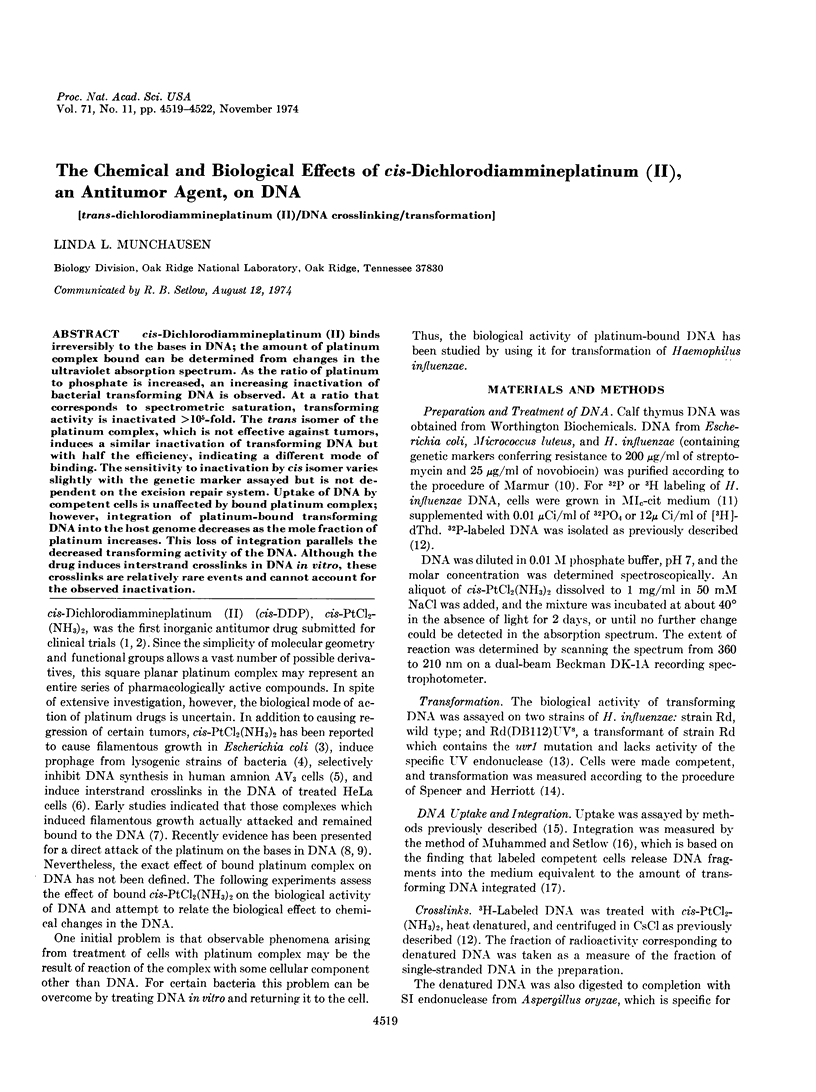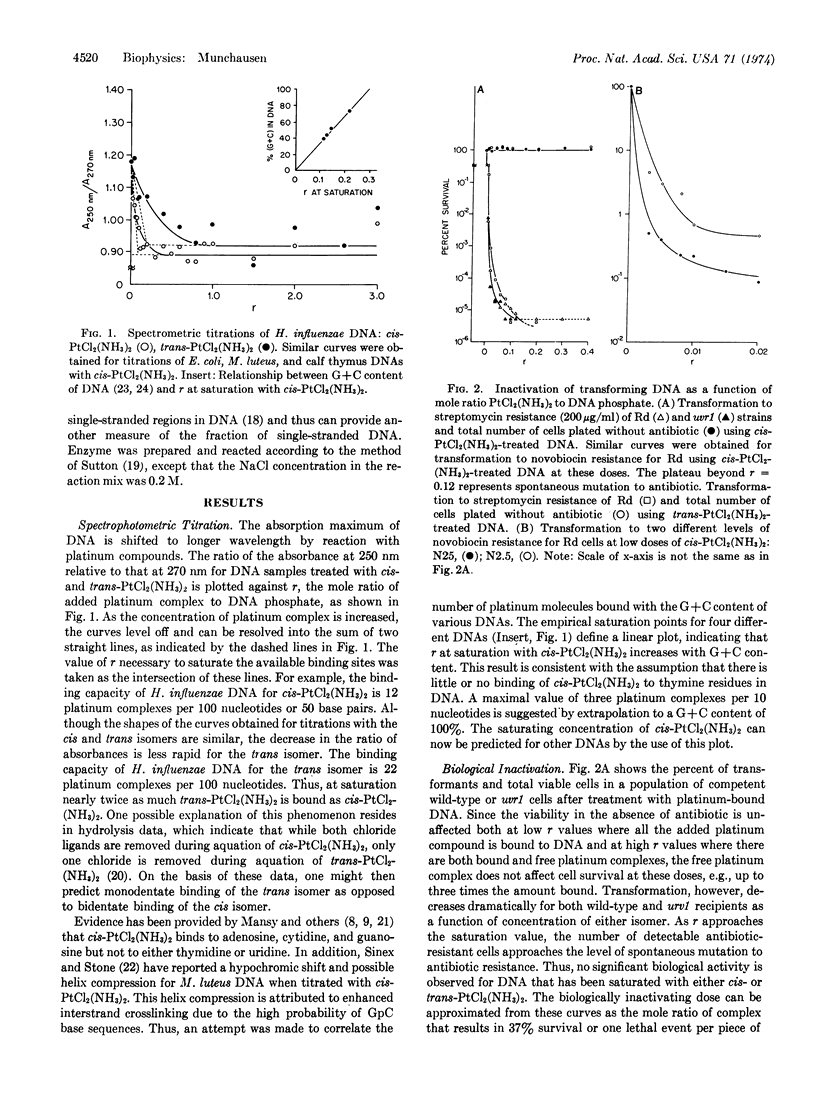Abstract
cis-Dichlorodiammineplatinum (II) binds irreversibly to the bases in DNA; the amount of platinum complex bound can be determined from changes in the ultraviolet absorption spectrum. As the ratio of platinum to phosphate is increased, an increasing inactivation of bacterial transforming DNA is observed. At a ratio that corresponds to spectrometric saturation, transforming activity is inactivated >105-fold. The trans isomer of the platinum complex, which is not effective against tumors, induces a similar inactivation of transforming DNA but with half the efficiency, indicating a different mode of binding. The sensitivity to inactivation by cis isomer varies slightly with the genetic marker assayed but is not dependent on the excision repair system. Uptake of DNA by competent cells is unaffected by bound platinum complex; however, integration of platinum-bound transforming DNA into the host genome decreases as the mole fraction of platinum increases. This loss of integration parallels the decreased transforming activity of the DNA. Although the drug induces interstrand crosslinks in DNA in vitro, these crosslinks are relatively rare events and cannot account for the observed inactivation.
Keywords: trans-dichlorodiammineplatinum (II), DNA crosslinking, transformation
Full text
PDF



Selected References
These references are in PubMed. This may not be the complete list of references from this article.
- Ando T. A nuclease specific for heat-denatured DNA in isolated from a product of Aspergillus oryzae. Biochim Biophys Acta. 1966 Jan 18;114(1):158–168. doi: 10.1016/0005-2787(66)90263-2. [DOI] [PubMed] [Google Scholar]
- Day R. S., 3rd, Rupert C. S. Ultraviolet sensitivity of Haemophilus influenzae transforming DNA. I. Effects of genetic mismatch and target size. Mutat Res. 1971 Mar;11(3):293–311. [PubMed] [Google Scholar]
- Drobník J., Horácek P. Specific biological activity of platinum complexes. Contribution to the theory of molecular mechanism. Chem Biol Interact. 1973 Oct;7(4):223–229. doi: 10.1016/0009-2797(73)90025-2. [DOI] [PubMed] [Google Scholar]
- Harder H. C., Rosenberg B. Inhibitory effects of anti-tumor platinum compounds on DNA, RNA and protein syntheses in mammalian cells in virtro. Int J Cancer. 1970 Sep 15;6(2):207–216. doi: 10.1002/ijc.2910060207. [DOI] [PubMed] [Google Scholar]
- Horácek P., Drobník J. Interaction of cis-dichlorodiammineplatinum (II) with DNA. Biochim Biophys Acta. 1971 Dec 16;254(2):341–347. doi: 10.1016/0005-2787(71)90842-2. [DOI] [PubMed] [Google Scholar]
- Mansy S., Rosenberg B., Thomson A. J. Binding of cis- and trans-dichlorodiammineplatinum(II) to nucleosides. I. Location of the binding sites. J Am Chem Soc. 1973 Mar 7;95(5):1633–1640. doi: 10.1021/ja00786a045. [DOI] [PubMed] [Google Scholar]
- Muhammed A., Setlow J. K. Ultraviolet-induced decrease in integration of Haemophilus influenzae transforming deoxyribonucleic acid in sensitive and resistant cells. J Bacteriol. 1970 Feb;101(2):444–448. doi: 10.1128/jb.101.2.444-448.1970. [DOI] [PMC free article] [PubMed] [Google Scholar]
- Notani N. K., Setlow J. K., Joshi V. R., Allison D. P. Molecular basis for the transformation defects in mutants of Haemophilus influenzae. J Bacteriol. 1972 Jun;110(3):1171–1180. doi: 10.1128/jb.110.3.1171-1180.1972. [DOI] [PMC free article] [PubMed] [Google Scholar]
- Randolph M. L., Setlow J. K. Mechanism of inactivation of transforming deoxyribonucleic acid by X rays. J Bacteriol. 1971 Apr;106(1):221–226. doi: 10.1128/jb.106.1.221-226.1971. [DOI] [PMC free article] [PubMed] [Google Scholar]
- Renshaw E., Thomson A. J. Tracer studies to locate the site of platinum ions within filamentous and inhibited cells of Escherichia coli. J Bacteriol. 1967 Dec;94(6):1915–1918. doi: 10.1128/jb.94.6.1915-1918.1967. [DOI] [PMC free article] [PubMed] [Google Scholar]
- Reslová S. The induction of lysogenic strains of Escherichia coli by cis-dichloro-diammineplatinum (II). Chem Biol Interact. 1971 Dec;4(1):66–70. doi: 10.1016/0009-2797(71)90034-2. [DOI] [PubMed] [Google Scholar]
- Roberts J. J., Pascoe J. M. Cross-linking of complementary strands of DNA in mammalian cells by antitumour platinum compounds. Nature. 1972 Feb 4;235(5336):282–284. doi: 10.1038/235282a0. [DOI] [PubMed] [Google Scholar]
- Rosenberg B., Van Camp L., Grimley E. B., Thomson A. J. The inhibition of growth or cell division in Escherichia coli by different ionic species of platinum(IV) complexes. J Biol Chem. 1967 Mar 25;242(6):1347–1352. [PubMed] [Google Scholar]
- Rosenberg B., VanCamp L., Trosko J. E., Mansour V. H. Platinum compounds: a new class of potent antitumour agents. Nature. 1969 Apr 26;222(5191):385–386. doi: 10.1038/222385a0. [DOI] [PubMed] [Google Scholar]
- Setlow R. B., Setlow J. K., Carrier W. L. Endonuclease from Micrococcus luteus which has activity toward ultraviolet-irradiated deoxyribonucleic acid: its action on transforming deoxyribonucleic acid. J Bacteriol. 1970 Apr;102(1):187–192. doi: 10.1128/jb.102.1.187-192.1970. [DOI] [PMC free article] [PubMed] [Google Scholar]
- Shooter K. V., Howse R., Merrifield R. K., Robins A. B. The interaction of plantinum II compounds with bacteriophages T7 and R17. Chem Biol Interact. 1972 Oct;5(5):289–307. doi: 10.1016/0009-2797(72)90069-5. [DOI] [PubMed] [Google Scholar]
- Spencer H. T., Herriott R. M. Development of competence of Haemophilus influenzae. J Bacteriol. 1965 Oct;90(4):911–920. doi: 10.1128/jb.90.4.911-920.1965. [DOI] [PMC free article] [PubMed] [Google Scholar]
- Steinhart W. L., Herriott R. M. Fate of recipient deoxyribonucleic acid during transformation in Haemophilus influenzae. J Bacteriol. 1968 Nov;96(5):1718–1724. doi: 10.1128/jb.96.5.1718-1724.1968. [DOI] [PMC free article] [PubMed] [Google Scholar]
- Wherland S., Deutsch E., Eliason J., Sigler P. B. Interactions between polynucleotides and platinum (II) complexes. Biochem Biophys Res Commun. 1973 Sep 18;54(2):662–668. doi: 10.1016/0006-291x(73)91474-5. [DOI] [PubMed] [Google Scholar]


